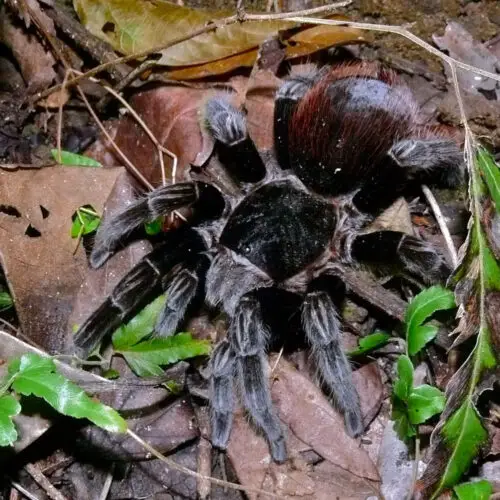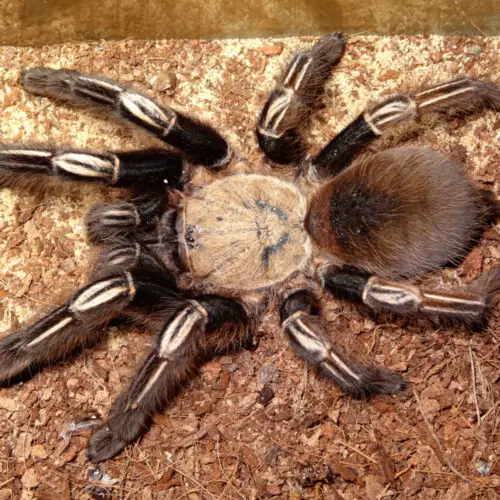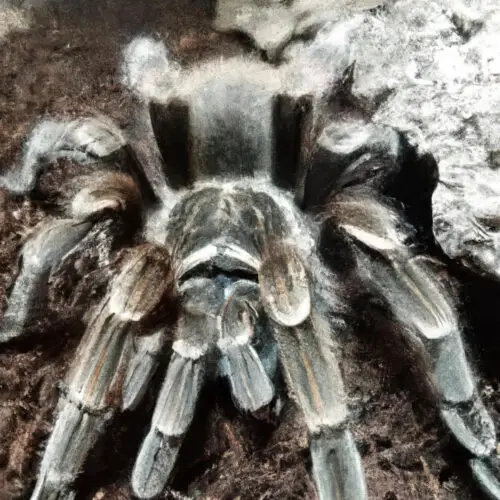The Colombian Giant Tarantula, also known as the Colombian giant redleg (Megaphobema robustum), is a species of tarantula that is native to Colombia. It is one of the largest species of tarantula, known for its impressive size and striking appearance. This article will delve into the characteristics, behavior, origin, natural habitat, care, health and diseases, diet and feeding, and breeding of the Colombian Giant Tarantula.
Characteristics
The Colombian Giant Tarantula is a large and robust species. Adult females can reach a leg span of up to 8 inches (20 centimeters), while males are slightly smaller, typically around 6 inches (15 centimeters) in leg span. The body and legs of the Colombian Giant Tarantula are covered in dense reddish-brown hair, giving it a vibrant and unique appearance. The carapace, or head, of the tarantula is dark brown or black, providing a contrast to the reddish-brown hairs covering its body.
Behavior
The Colombian Giant Tarantula is generally docile and slow-moving, making it a suitable pet for tarantula enthusiasts. It is not known for being aggressive, but like all tarantulas, it can bite if it feels threatened or provoked. The bite of the Colombian Giant Tarantula is usually not dangerous to humans, although some individuals may have an allergic reaction. When threatened, the tarantula may also kick off urticating hairs from its abdomen, which can cause irritation to the skin and eyes.
Origin
The Colombian Giant Tarantula is native to the tropical rainforests of Colombia. It can be found in the mountainous regions of the country, where it inhabits the forest floor and constructs burrows. The species is endemic to this region, meaning it is not found naturally in any other part of the world.
Natural Habitat
In its natural habitat, the Colombian Giant Tarantula prefers humid and warm environments. It thrives in areas with high rainfall and dense vegetation. The tarantula constructs burrows in the forest floor, which provides it with protection and a safe place to retreat. These burrows are lined with silk and can be quite deep, extending several feet underground. The Colombian Giant Tarantula is primarily nocturnal and spends most of its time in its burrow, venturing out at night to hunt for prey.
Care
When keeping the Colombian Giant Tarantula in captivity, it is important to replicate its natural habitat as closely as possible. A glass or plastic terrarium with secure ventilation is suitable for housing the tarantula. The substrate should be a mix of peat moss and coco fiber, providing a moist environment that mimics the tarantula’s natural habitat.
The terrarium should also contain hiding spots, such as cork bark or artificial shelters, where the tarantula can retreat to feel secure. The temperature and humidity levels in the enclosure should be maintained within the appropriate range for the species. A temperature of around 75-85°F (24-29°C) and a humidity level of 70-80% are recommended.
Health & Diseases
The Colombian Giant Tarantula is generally a hardy species, but it can be susceptible to certain health issues if its care requirements are not met. A common issue in tarantulas is dehydration, so it is important to provide a water dish in the enclosure and ensure that the tarantula always has access to fresh water. Regularly misting the enclosure can also help maintain proper humidity levels.
Another potential health concern for tarantulas is molting difficulties. Tarantulas molt periodically to grow and shed their old exoskeleton. During molting, the tarantula is vulnerable and may require extra care and vigilance. Providing a hiding spot and refraining from disturbing the tarantula during this time is crucial. If the tarantula experiences any difficulties or abnormalities during the molt, it may require veterinary attention.
Diet and Feeding
The Colombian Giant Tarantula is a carnivorous species, feeding primarily on insects and other small invertebrates. In captivity, it can be fed a variety of prey items, including crickets, roaches, and mealworms. The size of the prey should be appropriate for the size of the tarantula, as offering prey that is too large can pose a risk to the tarantula’s health.
Feeding should be done once or twice a week for adult tarantulas, and more frequently for growing juveniles. It is important to remove any uneaten prey items within 24 hours to prevent them from causing harm to the tarantula or the enclosure.
Breeding
Breeding the Colombian Giant Tarantula in captivity can be a complex process that requires careful planning and preparation. Sexing tarantulas can be difficult, especially when they are young. To breed, a mature male and female are required. The male should be introduced to the female’s enclosure, but it is essential to closely monitor their behavior to prevent any aggression or harm.
If successful, the male will deposit a sperm web, and the female will deposit eggs within her egg sac. The female will guard the egg sac until the spiderlings hatch. Once they hatch, the spiderlings can be separated into individual containers to prevent cannibalism.
Images
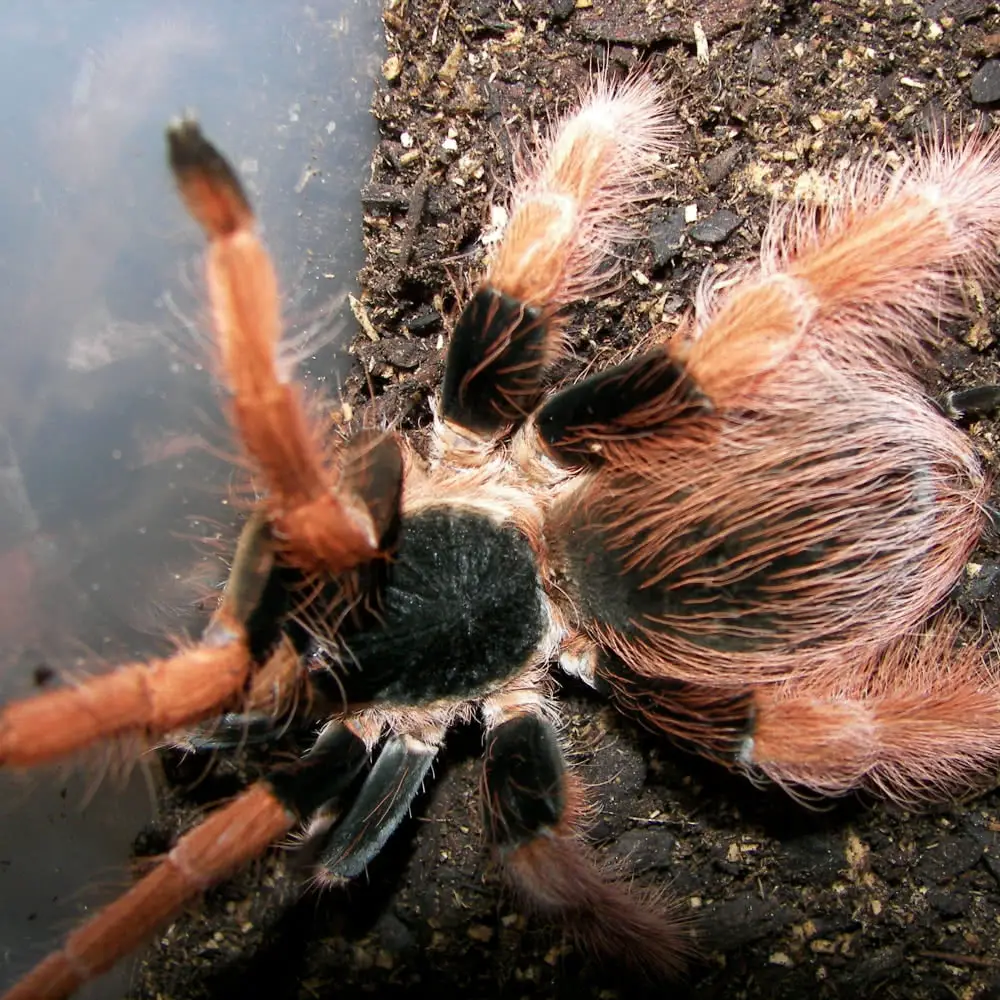
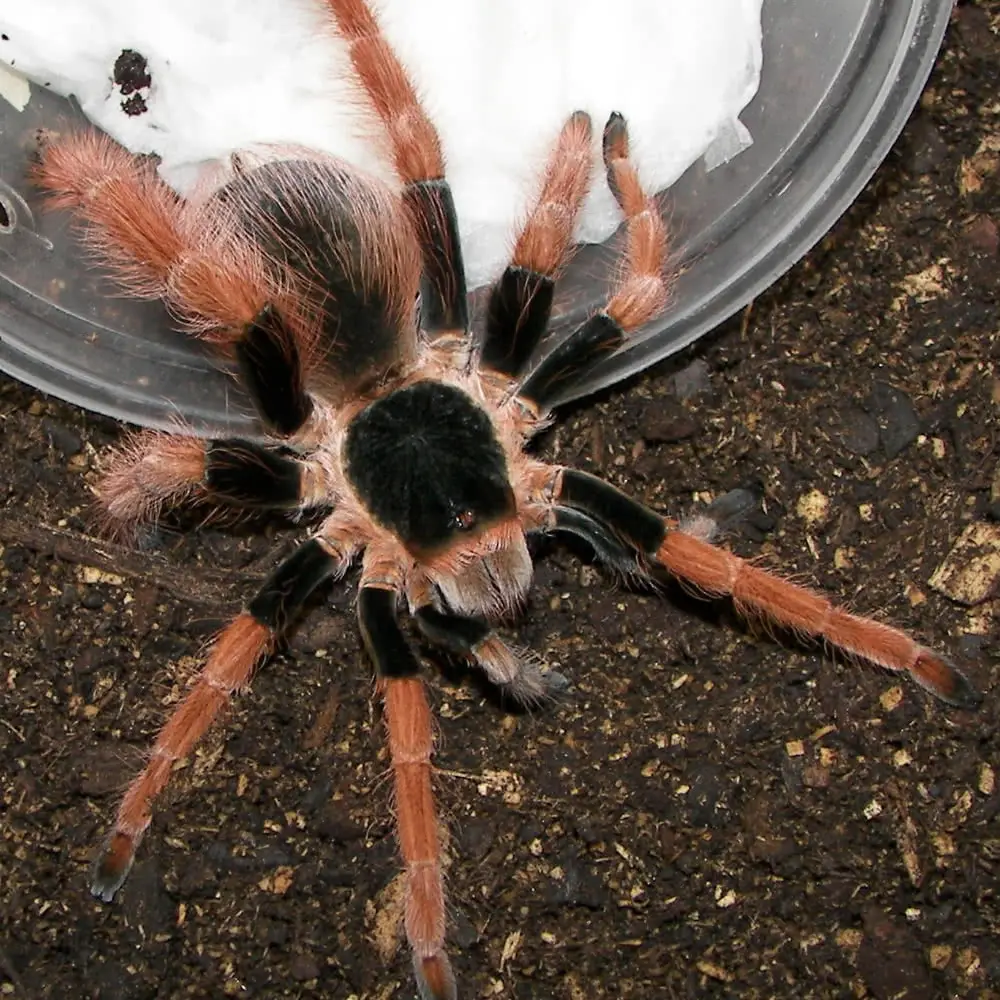
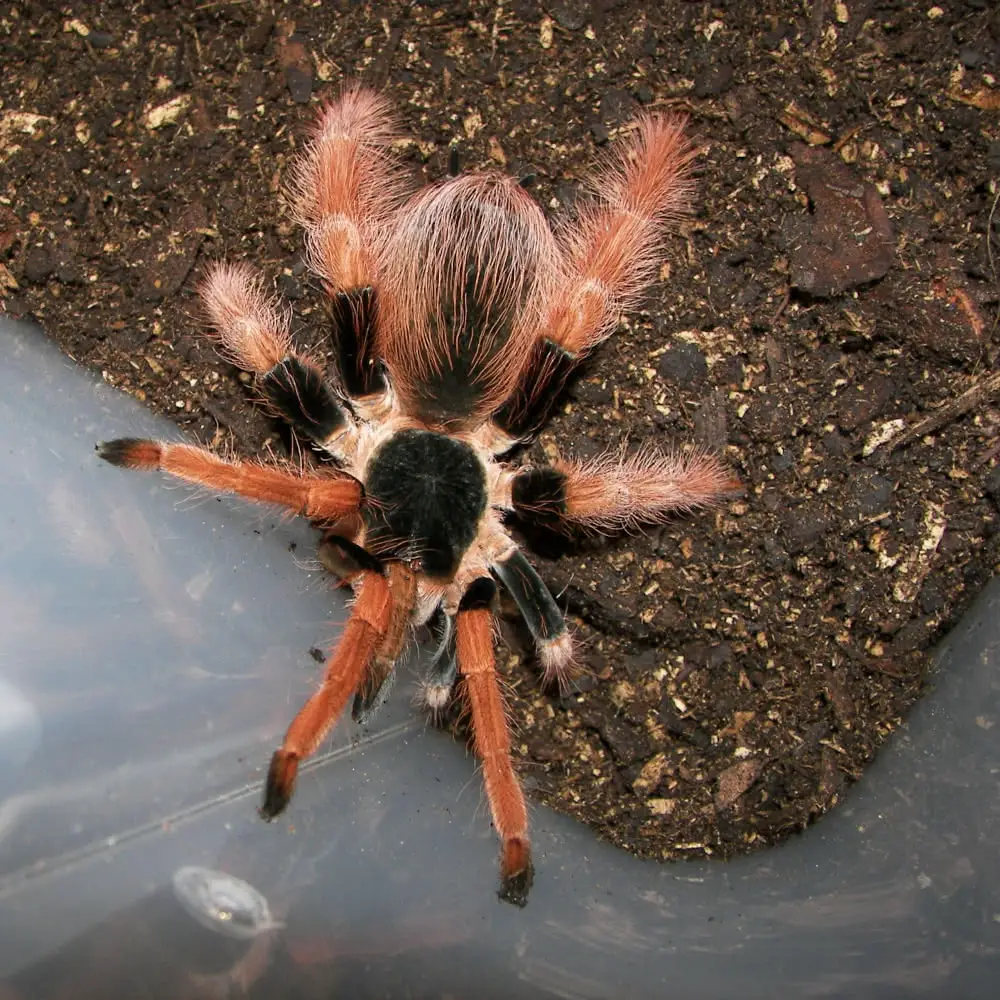
F.A.Q.
What is the scientific name for the Colombian Giant Tarantula?
The scientific name for the Colombian Giant Tarantula is Megaphobema robustum.
What are some common names for Megaphobema robustum?
Some common names for Megaphobema robustum include Skeleton Tarantula and Colombian Giant Redleg.
Where is the Colombian Giant Tarantula native to?
The Colombian Giant Tarantula is native to the tropical rainforests of Colombia.
How big do Colombian Giant Tarantulas get?
Colombian Giant Tarantulas can have a leg span of up to 7 inches (18 cm).
What is the average lifespan of a Colombian Giant Tarantula?
The average lifespan of a Colombian Giant Tarantula is around 10 to 12 years.
Are Colombian Giant Tarantulas venomous?
Yes, Colombian Giant Tarantulas are venomous, but their venom is not considered to be medically significant to humans.
Can Colombian Giant Tarantulas be kept as pets?
Yes, Colombian Giant Tarantulas can be kept as pets by experienced tarantula keepers.
Are Colombian Giant Tarantulas aggressive?
Colombian Giant Tarantulas are generally docile and not aggressive, but they can become defensive if they feel threatened.
How should Colombian Giant Tarantulas be housed?
Colombian Giant Tarantulas should be housed in spacious terrariums with appropriate ventilation and secure lids.
What temperature and humidity levels are ideal for Colombian Giant Tarantulas?
Ideal temperature for Colombian Giant Tarantulas is between 75-85°F (24-29°C) and humidity levels around 70-80%.
What substrate should be used for Colombian Giant Tarantulas?
A substrate mix of coco fiber, peat moss, and vermiculite works well for Colombian Giant Tarantulas.
Do Colombian Giant Tarantulas need any special lighting?
Colombian Giant Tarantulas do not require any special lighting and can be kept in normal room lighting.
What type of enclosure should be used for Colombian Giant Tarantulas?
Enclosures with secure lids, good ventilation, and enough space for the tarantula to move around are suitable for Colombian Giant Tarantulas.
Do Colombian Giant Tarantulas require any decorations in their enclosure?
While not necessary, decorations such as hides or fake plants can provide enrichment for Colombian Giant Tarantulas.
How often should the enclosure of a Colombian Giant Tarantula be cleaned?
The enclosure of a Colombian Giant Tarantula should be spot-cleaned regularly and completely cleaned and substrate changed every 3-6 months.
Can Colombian Giant Tarantulas be housed together?
No, Colombian Giant Tarantulas are solitary animals and should not be housed together as they may fight or cannibalize each other.
What is the recommended diet for Colombian Giant Tarantulas?
The recommended diet for Colombian Giant Tarantulas consists of a variety of live insects such as crickets, roaches, and mealworms.
How often should Colombian Giant Tarantulas be fed?
Adult Colombian Giant Tarantulas should be fed once every 1-2 weeks, while slings (young tarantulas) should be fed more frequently, about 2-3 times a week.
What are some suitable prey items for Colombian Giant Tarantulas?
Some suitable prey items for Colombian Giant Tarantulas include crickets, roaches, mealworms, and small locusts.
Can Colombian Giant Tarantulas be fed pre-killed prey?
Colombian Giant Tarantulas can be fed pre-killed prey, but they may not always accept it, as they prefer live prey.
How should Colombian Giant Tarantulas be handled?
Colombian Giant Tarantulas should be handled very cautiously, if at all, as they can be easily stressed or injured. It is generally recommended to avoid handling them.
Are Colombian Giant Tarantulas easy to handle?
No, Colombian Giant Tarantulas are not easy to handle and should only be handled by experienced tarantula keepers.
Do Colombian Giant Tarantulas bite humans?
While Colombian Giant Tarantulas have the capability to bite humans, they are generally docile and will only bite if they feel threatened or provoked.
What should I do if bitten by a Colombian Giant Tarantula?
If bitten by a Colombian Giant Tarantula, it is important to clean the wound thoroughly and seek medical attention if necessary, as an allergic reaction may occur.
Are there any risks associated with owning a Colombian Giant Tarantula?
Owning a Colombian Giant Tarantula carries certain risks, such as potential bites, allergies, or escape if not properly housed.
Do Colombian Giant Tarantulas require any special care during molting?
During molting, it is important to provide Colombian Giant Tarantulas with a humid environment and refrain from disturbing them, as they are vulnerable and delicate during this process.
How often do Colombian Giant Tarantulas molt?
Colombian Giant Tarantulas molt approximately once a year, although the frequency may vary depending on factors such as age and feeding schedule.
Can Colombian Giant Tarantulas regenerate lost legs or appendages?
No, Colombian Giant Tarantulas cannot regenerate lost legs or appendages. If a leg is lost, it will be permanently missing.
Are Colombian Giant Tarantulas noisy?
No, Colombian Giant Tarantulas are not noisy as they do not make vocalizations.
How can I sex a Colombian Giant Tarantula?
The sex of a Colombian Giant Tarantula can be determined by examining the morphology of the pedipalps, which show distinct differences between males and females.
Can Colombian Giant Tarantulas be bred in captivity?
Yes, Colombian Giant Tarantulas can be bred in captivity, but it requires specific conditions and expertise.
What is the breeding process for Colombian Giant Tarantulas?
The breeding process for Colombian Giant Tarantulas involves introducing a mature male to a receptive female’s enclosure and monitoring their behavior for successful mating.
Are there any specific health issues that affect Colombian Giant Tarantulas?
Colombian Giant Tarantulas are generally hardy, but they can be susceptible to issues such as fungal infections, mites, and dehydration if not provided with appropriate care.
What are some signs of illness or stress in Colombian Giant Tarantulas?
Some signs of illness or stress in Colombian Giant Tarantulas include loss of appetite, lethargy, excessive hiding, unusual aggression, or visible physical abnormalities.
Can Colombian Giant Tarantulas jump or climb walls?
No, Colombian Giant Tarantulas are not known for their jumping abilities, and while they can climb, they prefer to stay on the ground or in low branches.
Are Colombian Giant Tarantulas good escape artists?
Colombian Giant Tarantulas have been known to escape from poorly secured enclosures, so it is important to ensure their enclosure is escape-proof.
Can Colombian Giant Tarantulas live together with other species of tarantulas?
It is generally not recommended to house different species of tarantulas together as they may fight or cannibalize each other.
Are Colombian Giant Tarantulas cannibalistic?
Colombian Giant Tarantulas can exhibit cannibalistic behavior if housed together or during the mating process, so it is best to keep them isolated.
How can I tell if my Colombian Giant Tarantula is preparing to molt?
Signs that a Colombian Giant Tarantula is preparing to molt include reduced appetite, increased inactivity, and a darkening of the exoskeleton.
Can Colombian Giant Tarantulas be found in the wild?
Yes, Colombian Giant Tarantulas can be found in the wild in the tropical rainforests of Colombia.
Are Colombian Giant Tarantulas protected by law?
The legal protection of Colombian Giant Tarantulas may vary depending on the country or region, so it is important to check local regulations.
What are some common behavioral traits of Colombian Giant Tarantulas?
Colombian Giant Tarantulas are generally docile and solitary, preferring to spend their time hiding or exploring their enclosure at night.
How can I tell the age of a Colombian Giant Tarantula?
It is difficult to determine the exact age of a Colombian Giant Tarantula, as growth rates can vary, but certain characteristics such as size and maturity can provide some indication.
Can Colombian Giant Tarantulas swim?
While Colombian Giant Tarantulas can technically survive being submerged in water, they are not adapted for swimming and could drown if not promptly rescued.
Can Colombian Giant Tarantulas be kept in groups?
No, Colombian Giant Tarantulas are solitary animals and should be kept individually to avoid potential aggression or cannibalism.
Can Colombian Giant Tarantulas be trained?
No, Colombian Giant Tarantulas do not have the cognitive capabilities for training and do not respond to commands or stimuli in the same way as domesticated animals.
How can I create a naturalistic habitat for a Colombian Giant Tarantula?
A naturalistic habitat for a Colombian Giant Tarantula can be created by using appropriate substrate, live plants, and decorations that mimic their native rainforest environment.
Can Colombian Giant Tarantulas be housed with other arachnids or insects?
While Colombian Giant Tarantulas can be housed with certain species of invertebrates in appropriate setups, it is important to research compatibility and provide adequate space and resources for all animals involved.
Are Colombian Giant Tarantulas more active during the day or night?
Colombian Giant Tarantulas are primarily nocturnal and tend to be more active and visible during the night.
Can Colombian Giant Tarantulas be kept in a communal setup with other tarantulas?
No, Colombian Giant Tarantulas are solitary animals and should not be housed together in a communal setup as it can lead to aggression and cannibalism.
Conclusion
The Colombian Giant Tarantula is a fascinating species that captivates enthusiasts with its size, appearance, and relatively docile nature. With proper care and attention to its specific needs, this tarantula can thrive in captivity. It is crucial to provide a suitable enclosure, maintain appropriate temperature and humidity levels, and offer a balanced diet. By ensuring the well-being of the Colombian Giant Tarantula, enthusiasts can enjoy the beauty and wonder of this impressive arachnid.
Image credits:

